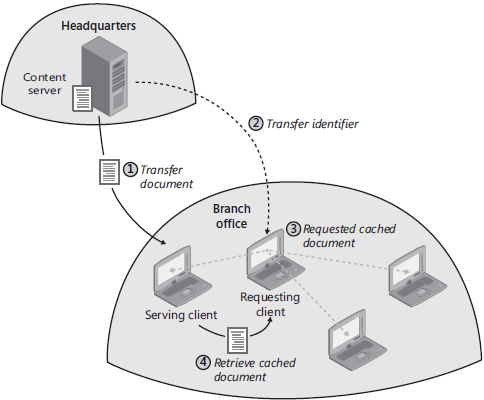How Distributed Cache Works
The process is similar to that used by Hosted Cache mode, except requests for cached content are multicast to the local network and a Hosted Cache server is not required:
- A client running Windows 7 connects to the content server and requests data. The server authorizes the user and returns an identifier. Because this is the first time any client has attempted to retrieve the file, it is not already cached on the local network. Therefore, the client retrieves the file directly from the content server and uses Branch- Cache to cache it on its hard disk.
- A second requesting client running Windows 7 requests the same file from the content server. Again, the content server authorizes the user and returns an identifier.
- The requesting client sends a request to its peers on the local network for the required file using the WS-Discovery multicast protocol.
- The client that previously cached the file becomes the serving client and sends the file to the requesting client. The data is encrypted using an encryption key derived from the hashes. The client decrypts the data, validates it, and passes it to the application.

In this tutorial:
- Configuring Windows Networking
- Usability Improvements
- Network And Sharing Center
- Network Explorer
- How Windows Finds Network Resources
- How Windows Publishes Network Resources
- How Windows Creates the Network Map
- Network Map
- Set Up A Connection Or Network Wizard
- Manageability Improvements
- Network Location Types
- Policy-Based QoS
- Selecting DSCP Values
- Planning Traffic Throttling
- Configuring QoS Policies
- Configuring System-Wide QoS Settings
- Configuring Advanced QoS Settings
- Testing QoS
- Windows Firewall and IPsec
- Windows Connect Now in Windows 7
- Core Networking Improvements
- Networking BranchCache
- How Hosted Cache Works
- How Distributed Cache Works
- Configuring BranchCache
- BranchCache Protocols
- File Sharing Using SMB
- Web Browsing with HTTP (Including HTTPS)
- DNSsec
- GreenIT
- Efficient Networking
- What Causes Latency, How to Measure It, and How to Control It
- TCP Receive Window Scaling
- Scalable Networking
- Improved Reliability
- IPv6 Support
- 802.1X Network Authentication
- Server Message Block (SMB) 2.0
- Strong Host Model
- Wireless Networking
- Improved APIs
- Network Awareness
- Improved Peer Networking
- Services Used by Peer-to-Peer Networking
- Managing Peer-to-Peer Networking
- Peer-to-Peer Name Resolution
- EAP Host Architecture
- Layered Service Provider (LSP)
- Windows Sockets Direct Path for System Area Networks
- How to Configure Wireless Settings
- Configuring Wireless Settings Manually
- Using Group Policy to Configure Wireless Settings
- How to Configure TCP/IP
- DHCP
- Configuring IP Addresses Manually
- Command Line and Scripts
- How to Connect to AD DS Domains
- How to Connect to a Domain When 802.1X Authentication Is Not Enabled
- How to Connect to a Domain When 802.1X Authentication Is Enabled
